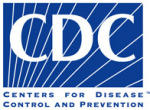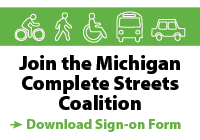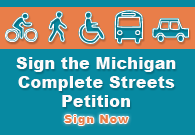By Barbara McCann - National Complete Streets Coalition
 The Centers for Disease Control and Prevention (CDC) is recommending that communities adopt complete streets policies in their fight against obesity – and has recommended using our Coalition’s standards to measure their success. The development is one in a new flurry of study results, meetings, and reports from the public health community are pointing the way toward complete streets policies as an important tool in the fight against the obesity crisis.
The Centers for Disease Control and Prevention (CDC) is recommending that communities adopt complete streets policies in their fight against obesity – and has recommended using our Coalition’s standards to measure their success. The development is one in a new flurry of study results, meetings, and reports from the public health community are pointing the way toward complete streets policies as an important tool in the fight against the obesity crisis.
This week the CDC pushed beyond its traditional comfort zone to recommend policy strategies for obesity prevention, and outlined them in a report in the influential Morbidity and Mortality weekly report (MMWR). Six of the 24 recommendations relate directly to complete streets and smart growth, with one making specific reference to complete streets: enhance traffic safety in areas where people are or could be physically active. The suggested measure for communities to use is as follows:
Local government has a policy for designing and operating streets with safe access for all users which includes at least one element suggested by the National Complete Streets Coalition (www.completestreets.org).
This measurement assesses whether a community has a policy for all-user street design, such as the Complete Streets program. Specific elements of the measurement are based on Complete Streets policy.
The other recommendations include:
- Enhance infrastructure supporting walking.
- Enhance infrastructure supporting bicycling.
- Improve access to public transportation.
- Zone for mixed-use development.
- Support locating schools within easy walking distance of residential areas.
And another represents the way many communities are pursuing complete streets:
- Participate in community coalitions or partnerships to address obesity.
The new strategies were introduced at CDC’s Weight of the Nation conference, with a strong focus on environmental change that was previewed in a prominent USA Today story that discussed complete streets. I spoke at the conference about the tremendous growth in complete streets policy adoption across the country, often spearheaded by groups with a mission to improve physical activity, such as Blue Cross Blue Shield of Minnesota’s commitment to active living, YMCA’s Achieve Communities, and Kellogg’s Food and Fitness initiative. The complete streets message was also carried throughout the meeting by many others. Walking guru Mark Fenton highlighted complete streets policy initiatives. Most notably, Senator Tom Harkin spoke about the Complete Streets Act of 2009 and his determination to make it law.
Another prominent player at the conference was the Convergence Partnership, a group of funders who are working together to fund healthier communities. The Partnership commissioned The Transportation Prescription: Bold New Ideas for Healthy, Equitable Transportation Reform in America, issued by PolicyLink and the Prevention Institute. The report zeroes in on how transportation policies can help improve health and recommends adoption of complete streets policies. A few weeks ago, the Trust for America’s Health issued the 2009 edition of F as in Fat: How Obesity Policies Are Failing in America, calling for a sea change in obesity prevention policies, including environmental changes such as complete streets.
Next Tuesday, the Robert Wood Johnson Foundation is hosting a free webinar on creating healthy communities by improving the built environment and integrating safety and wellness into all aspects of the community. This is the second of three webinars focused on recommendations made by The Robert Wood Johnson Foundation Commission to Build a Healthier America.
The critical need to create streets that are safe and inviting for physical activity for young and old has become one of the driving forces behind our movement.

 Find us on Facebook
Find us on Facebook Follow us on Twitter
Follow us on Twitter












No comments yet
Comments feed for this article